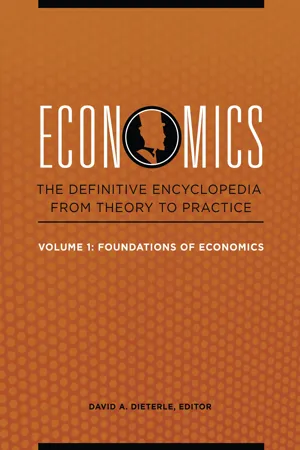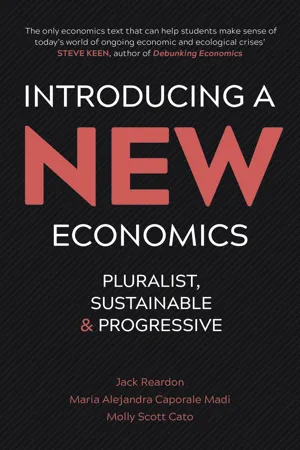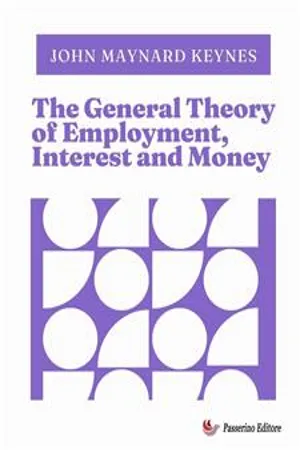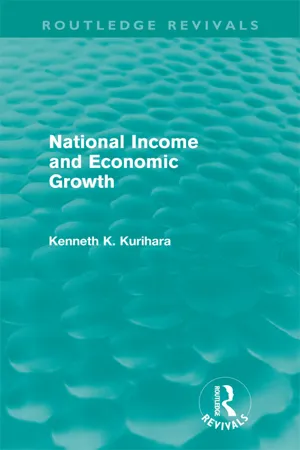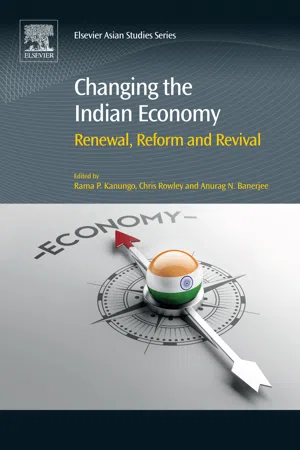Economics
Multiplier
The multiplier refers to the concept in economics where an initial increase in spending leads to a larger final increase in national income. It measures the overall impact of an initial change in investment or government spending on the economy. The multiplier effect is a key component of fiscal policy and is used to assess the potential outcomes of government spending and taxation changes.
Written by Perlego with AI-assistance
Related key terms
Related key terms
1 of 4
Related key terms
1 of 3
10 Key excerpts on "Multiplier"
- eBook - ePub
Principles of Macroeconomics
Activist vs. Austerity Policies
- Howard J. Sherman, Michael A. Meeropol, Paul D. Sherman(Authors)
- 2018(Publication Date)
- Routledge(Publisher)
Fifth, the Multiplier concept in our example leaves out all references to exports and imports. In the real world, increased spending for foreign imports removes some portion of income from the domestic Multiplier process.In spite of its limitations, the conclusion is that the investment Multiplier concept is very useful for understanding the business cycle and for making government policy. The simplest form of it, however, is far from perfect. To summarize: (1) the Multiplier effect takes time and is not instantaneous; (2) the further effects on investment itself are left out; (3) the distribution of income of those who receive the initial income affects the outcome; (4) some money leaks out in tax payments to all levels of government; (5) corporations may not spend their retained earnings on goods or services; (6) changes in wealth and indebtedness influence the MPC out of current DPI; and (7) some consumption leaks out into money spent on imports from foreign countries.A more detailed explanation of why empirical Multipliers are significantly lower than the theoretical Multipliers developed here is presented in Appendix 10.2 .The Investment Multiplier and the Virtuous Circle
The investment Multiplier says that adding $10 billion of new investment at the bottom of a recession will cause more than $10 billion of stimulus to the economy. Certainly, it will cause a certain amount of re-spending of the $10 billion in the form of consumer goods and services. It can be thought of as:Investment → Added ConsumptionBut that is not all. The added consumption leads to still more consumption. All of this new consumer spending arouses the interest of individual and corporate businesses both large and small. The business outlook changes from one with few sales to a boom. Such a profitable outlook leads to plans for more investment. Thus, the process reverberates back from stronger consumption to more new investment:Added Consumption → InvestmentThe increasing rate of growth in GDP also increases the optimism of consumers. As a result, many are willing to borrow, making consumption rise even faster than normal. The MPC itself may actually rise as a result of that optimism, further fueling the optimism of investors. - eBook - ePub
Economics
The Definitive Encyclopedia from Theory to Practice [4 volumes]
- David A. Dieterle(Author)
- 2017(Publication Date)
- Greenwood(Publisher)
As one can see from the example, MPC ($0.90) and MPS ($0.10) equal one marginal dollar received by the taxpayer or provided by the government. Knowing the marginal propensity to consume and marginal propensity to save, policymakers also know, in theory, that the impact of their actions will not be a straight dollar-for-dollar exchange. Rather, each marginal dollar added to or taken away from the economy will be multiplied as it makes its way through the economy from business to labor and back to business (i.e., through the circular flow of economic activity). To determine the Multiplier impact of the marginal dollar, one also needs to know the Multiplier effect.Multiplier EffectThe Multiplier effect is influenced by the MPC, MPS, and the injection of new dollars into the economy or removed as the result of increased taxes. Each time the level of money changes in an economy a Multiplier effect occurs. To predict the Multiplier effect of a potential policy action, divide 1 by 1 – MPC (1 / 1 – MPC). Or, since it is known that MPC and MPS must equal 1, another way of expressing the Multiplier effect is 1 / MPS.Returning to the above example, if MPC = $0.90, the Multiplier effect is 10 (1 / 1 –0.90 = 1 / 0.1 = 10). So policymakers can now predict that for every $1 they give back to the taxpayer, $10 will be generated in the economy.Tax cut recipients have been known to not follow the theory and consequently frustrate policymakers. Because of the recessionary economy of the early 2000s, the Bush and Obama tax cuts begun in 2001 did not fully meet expectations of increasing economic activity. Instead of following Keynesian theory and increasing consumer spending in the economy, many taxpayers used their new marginal dollars to pay off credit card debt (past spending) or increased saving because of the slow economy and an uncertain future, frustrating both fiscal and monetary policy leaders.Whitney WellmanDavid A. DieterleSee also: Vol. 1 : Foundations of Economics: Keynes, John Maynard; Keynesian Economics; Vol. 2 : Macroeconomics: Fiscal Policy; Macroeconomics; Multiplier Effect; TaxesFurther ReadingAmosWeb. 2015. Marginal propensity to consume. www.amosweb.com/cgibin/awb_nav.pl?s=wpd&c=dsp&k=marginal+propensity+to+consume (accessed December 10, 2015).AmosWeb. 2015. Marginal propensity to save. www.amosweb.com/cgibin/awb_nav.pl?s=wpd&c=dsp&k=marginal%20propensity%20to%20save (accessed December 10, 2015).Businessdictionary. 2015. Marginal propensity to save. www.businessdictionary.com/definition/marginal-propensity-to-save.html - eBook - ePub
- Alvin H Hansen(Author)
- 2013(Publication Date)
- Routledge(Publisher)
General Theory. The magnitude of the leakages is determined by the portion of the marginal income which is not used for consumption expenditures, or, in other words, is saved. Thus, if the percentage saved is zero, the Multiplier is infinity. If the fraction which is saved is one tenth, the Multiplier is ten; if one fifth, five; if one third, three; if one half, two; and, finally, if 100 per cent is saved, the Multiplier is one, and, similarly, for intervening points. The Multiplier is thus the reciprocal of the marginal propensity to save, which determines the ratio of marginal saving to marginal income received. The Multiplier can equally well be stated in terms of the marginal propensity to consume. The Multiplier (K) stated in terms of the marginal propensity-to-consumeFrom Charts 15 and 16 it is readily apparent that the income will not remain at the new high level reached unless the private investment or governmental outlays continue to be poured out in a continuous stream. As soon as the governmental expenditures are withdrawn, the income again falls to its previous level. This phenomenon is in no sense a peculiarity of governmental spending, but is equally true of private investment expenditures.The Acceleration PrincipleThus, the Multiplier Principle concerns exclusively the effect of private investment expenditure or governmental expenditure, as the case may be, upon subsequent net additions to consumption expenditure. The Acceleration Principle, to which we now turn, concerns exclusively the effect of a net increase in consumption expenditures upon induced investment expenditures. If we are to measure the full effect of private investment expenditures or governmental expenditures, as the case may be, on income, we must take account of both the Multiplier and the Acceleration Principle; we must measure not only the effect of these initial expenditures upon subsequent consumption, but also the effect of the subsequent increases in consumption upon investment induced by increase in consumption expenditures.The volume of replacement investment expenditures is determined by the volume of consumption expenditures. In the event that consumption expenditures remain constant, no new - eBook - ePub
Introducing a New Economics
Pluralist, Sustainable and Progressive
- Jack Reardon, Maria Alejandra Caporale Madi, Molly Scott Cato(Authors)
- 2017(Publication Date)
- Pluto Press(Publisher)
Have you ever stood on the shore of a lake or river and thrown a stone into the water, watching the initial plop, then the rippling in every direction? This mental picture can help you to understand the Multiplier, an important concept in economics. Think of the initial plop as additional spending, perhaps investment, which then creates a ripple effect, extending through the economy. The Multiplier in effect measures the economic rippling, and we use it to ask a very important question: What is the total effect of increased spending?The spending Multiplier (M)measures the magnified change in aggregate income (GDP) resulting from a change in spending; more specifically, M is defined as the amount income changes when spending increases by one unit. The MPC, discussed above, affects the Multiplier process, along with the magnitude of the induced consumption.Let’s look at an example. Say you get a gift of £500. Your income immediately increases by £500. Then you decide to take your whole economics class (and your professor!) out to lunch. The proprietor of the restaurant is happy for the added business – her income has now increased by £500 thanks to you. Let’s say she then uses all of the £500 to fix a leak in the roof. She calls the roofer immediately; the roofer obliges, and is now £500 richer. Now assume the roofer spends the £500 on office supplies, increasing the supplier’s income by £500.How long can this process continue and when will it end? Just like throwing a rock into the water, the ripple generates a forward motion which runs into the resistance of the water – an opposing force that slows the motion down. The larger the initial plop, the larger the ripple, but eventually, given the resistance of the water, it must stop. The same applies to your £500: it eventually must stop, given any ‘leakages’, i.e. money that is not consumed, or money that is saved. Say for example that instead of spending your initial £500, you put it under your mattress. There is an initial plop, yes – your income has now increased, but there is no ripple. Only you have become richer and no one else.Spending all of the £500 or none of it are two extremes; in reality, you are more likely to spend or save some. Or would you? Say you only spend £200 but still spend it on taking your fellow students to lunch (and of course your professor). Now what happens? Of course the restaurant owner’s income has increased, thanks to you, but only by £200, so perhaps she cannot fix the roof, so let’s say she uses the money to repair a refrigerator, but also keeps £50 for her daughter’s birthday. The repair person is now £150 better off, but what does he do with the money? Let’s say he pays back taxes of £100 and buys a new coat with the remainder. The clothing store owner is now £50 richer. - eBook - ePub
- Claude Gnos, Louis-Philippe Rochon(Authors)
- 2008(Publication Date)
- Routledge(Publisher)
In its logical form, which is usually termed its ‘static form’, the Multiplier cannot therefore be interpreted as a theory of adjustment of magnitudes making up national income. It is a theory of ‘the order of events’ in that it makes a distinction in macroeconomics between the expenditure that forms and the expenditure that disposes of national income. The formation of income is dependent on the expectations of entrepreneurs about how their output will find outlets either with households or with other firms. However, not all of the income formed in the investment goods sector is saved and not all of the income formed in the consumption goods sector is consumed. The workers who produce investment goods consume and those who produce consumption goods save. This means that aggregate income is ultimately and actually determined when it is spent in the various markets for goods and securities. The logical Multiplier reflects the precise point at which incomes formed in the two sectors are not spent directly on purchasing the products to which they correspond, but that nonetheless the spending structure is congruent with the income-formation structure. The amount equivalent to the income formed in the consumption sector is spent in purchasing consumption goods, while the amount equivalent to the income formed in the capital goods sector is spent in purchasing capital goods.Understood in the context of the law that saving equals investment, ‘the Multiplier is ultimately just a factor of proportionality’ (Schmitt, 1971, p. 96) that makes it possible to calculate the respective shares of national income made over to consumption (and therefore saving) and investment. It marks the objective connection between entrepreneurs’ production decisions and spending by households and firms in product markets. In other words, the logical Multiplier is the proportional rule serving as the quantitative relation which, in view of the behaviour of income-holders with regard to consumption, develops between the volume of output of goods intended for investment and the volume of output of goods intended for consumption.It indicates, while being reversed in a sense as it expresses expenditure in product markets, that production for consumption must give rise to income in an amount that is a determined multiple of the amount of income formed in the production of capital goods. In his 1937 paper The General Theory of Employment, - John Maynard Keynes(Author)
- 2023(Publication Date)
- Passerino(Publisher)
10. The Marginal Propensity to Consume and the Multiplier
WE established in Chapter 8 that employment can only increase pari passu with investment. We can now carry this line of thought a stage further. For in given circumstances a definite ratio, to be called the Multiplier, can be established between income and investment and, subject to certain simplifications, between the total employment and the employment directly employed on investment (which we shall call the primary employment). This further step is an integral part of our theory of employment, since it establishes a precise relationship, given the propensity to consume, between aggregate employment and income and the rate of investment. The conception of the Multiplier was first introduced into economic theory by Mr. R. F. Kahn in his article on “The Relation of Home Investment to Unemployment” ( Economic Journal, June 1931). His argument in this article depended on the fundamental notion that, if the propensity to consume in various hypothetical circumstances is (together with certain other conditions) taken as given and we conceive the monetary or other public authority to take steps to stimulate or to retard investment, the change in the amount of employment will be a function of the net change in the amount of investment; and it aimed at laying down general principles by which to estimate the actual quantitative relationship between an increment of net investment and the increment of aggregate employment which will be associated with it. Before coming to the Multiplier, however, it will be convenient to introduce the conception of the marginal propensity to consume.IThe fluctuations in real income under consideration in this book are those which result from applying different quantities of employment ( i.e. of labour-units) to a given capital equipment, so that real income increases and decreases with the number of labour-units employed. If, as we assume in general, there is a decreasing return at the margin as the number of labour-units employed on the given capital equipment is increased, income measured in terms of wage-units will increase more than in proportion to the amount of employment, which, in turn, will increase more than in proportion to the amount of real income measured (if that is possible) in terms of product. Real income measured in terms of product and income measured in terms of wage-units will, however, increase and decrease together (in the short period when capital equipment is virtually unchanged). Since, therefore, real income, in terms of product, may be incapable of precise numerical measurement, it is often convenient to regard income in terms of wage-units (Y w ) as an adequate working index of changes in real income. In certain contexts we must not overlook the fact that, in general, Y w- John Maynard Keynes(Author)
- 2016(Publication Date)
- Youcanprint(Publisher)
Chapter 10 - The Marginal Propensity to Consume and the Multiplier
We established in chapter 8 that employment can only increasepari passuwith investment unless there is a change in the propensity to consume. We can now carry this line of thought a stage further. For in givencircumstances a definite ratio, to be called theMultiplier, can be established between income and investment and, subject to certain simplifications, between the total employment and the employment directly employed on investment (which we shall call theprimary employment). This further step is an integral partof our theory of employment, since it establishes a precise relationship, given the propensity to consume, between aggregate employment and income and the rate of investment. The conception of the Multiplier was first introduced into economic theory by MrR. F. Kahn in his article on ‘The Relation of Home Investment to Unemployment’ (Economic Journal, June 1931). His argument in this article depended on the fundamental notion that, if the propensity to consume in various hypothetical circumstances is (together with certain other conditions) taken as given and we conceive the monetary or other public authority to take steps to stimulate or to retard investment, the change in the amount of employment will be a function of the net change in the amount of investment; and it aimed at laying down general principles by which to estimate the actual quantitative relationship between an increment of net investment and the increment of aggregate employment which will be associated with it. Before coming to the Multiplier, however, it will be convenient to introduce the conception of themarginal propensity to consume.i
The fluctuations in real income under consideration in this book are those which result from applying different quantities of employment (i.e. of labour-units) to a given capital equipment, so that real income increases and decreases with the number of labour-units employed. If, as we assume in general, there is a decreasing return at the margin as the number of labour-units employed on the given capital equipment is increased, income measured in terms of wage-units will increase more than in proportion to the amount of employment, which, in turn, will increase more than in proportion to the amount of real income measured (if that is possible) in terms of product. Real income measured interms of product and income measured in terms of wage-units will, however, increase and decrease together (in the short period when capital equipment is virtually unchanged). Since, therefore, real income, in terms of product, may be incapable of precise numerical measurement, it is often convenient to regard income in terms of wage-units (Yw) as an adequate working index of changes in real income. In certain contexts we must not overlook the fact that, in general,Ywincreases and decreases in a greater proportion than real income; but in other contexts the fact that they always increase and decrease together renders them virtually interchangeable.- Kenneth Kenkichi Kurihara(Author)
- 2012(Publication Date)
- Routledge(Publisher)
.Since the marginal propensity to consume is the inverse of the marginal propensity to consume, , it is possible to express, as does Keynes in his pioneering theory of ‘the investment Multiplier,’1 equation (6) in the alternative formThe Multiplier equation expressed by (6) or (8) indicates that national income is capable of varying in direct proportion as investment changes, when the marginal propensity to save remains constant. The reduced Multiplier equation of the form expressed by (7) is the simplest yet most basic form which can and will be made as complicated as the analysis of more complex situations may require.Assume, further, that a change in total labour input is related to a change in total output in the technological formwhere v’ is the marginal labour-output ratio determined by the prevailing state of technology. From (9) and (7) we have the basic employment Multiplier mechanism of the formwhich shows that total employment can change by a magnitude equal to the marginal labour-output ratio times the Multiplier times a change in investment. Equation (10) presumes that real national income equals output or Ym /p = Yr = Y, as discussed in the previous chapter.The Multiplier CoefficientTurning now to the various elements of the Multiplier theory, let us first inquire into the Multiplier coefficient (k). The Multiplier coefficient refers to the power by which any initial expenditure is multiplied to obtain a final increase (or decrease) in national income. Statically speaking, a discrete value of the Multiplier can be found by calculating the reciprocal of the marginal propensity to save considered as a constant. Table 6- eBook - ePub
Changing the Indian Economy
Renewal, Reform and Revival
- Rama P. Kanungo, Chris Rowley, Anurag N. Banerjee(Authors)
- 2018(Publication Date)
- Elsevier(Publisher)
Snowdown and Vane, 2005 ). The global financial crisis has also reopened the debate on the growth effectiveness of public expenditure.Although there are vast amounts of literature on fiscal Multipliers, macroeconomists lack a consensus regarding the definitive value across economies and contexts. The value of the Multiplier varies during growth and recession, and inaccurate estimation could wreak havoc on the desired outcomes (Auerbach and Gorodnichenko, 2011 ; Blanchard and Leigh, 2013 ). For instance, Ilzetzki et al. (2013) used data from 44 countries to examine the role of country characteristics and concluded that the long-run fiscal Multipliers were smaller in developing countries, open economies, flexible exchange rate regimes and periods of high public debt (Perotti, 1999 ). Studies also showed that the Multiplier was sensitive to interest rates and that fiscal policy was more effective when interest rates did not respond to the fiscal stimulus (Alumnia et al., 2010 ; Christiano et al., 2011 ; Devereux, 2010 ; Woodford, 2011 ). Barro and Redlick (2009) show that fiscal Multipliers will be large when there are tight conditions in the labour market.The study regarding the effect of public expenditure on output in India gained prominence after the global financial crisis of 2008. Policy concerns due to the global shocks have increased the focus on the development of analytical models to estimate the effect of the fiscal Multiplier. India has a long history of fiscal mismanagement that is associated with high levels of financial debts and deficits. Following the adoption of the FRBM Act in 2003, the union and state governments in India committed to engage in prudent fiscal spending and eliminate revenue deficits on account of unproductive spending. Thus understanding the nature and magnitude of fiscal Multipliers could be helpful for formulating a strategy to wisely allocate scarce resources. In this regard, the major conclusions based on the existing studies are summarized below. - eBook - ePub
- Subrata Ghatak(Author)
- 2003(Publication Date)
- Routledge(Publisher)
Y) will also rise by £100 million.More formally, letwhere I is autonomous investment (fixed), C is consumption (C = bY), Y is income and G is government expenditure. ThenThe effect of a change in public expenditure is thenwhere b is the marginal propensity to consume (MPC) and 1/(1 – b) is the Multiplier. ThenNext, to find out the effect of changes in taxes (ΔT) on income (Y), note that when taxes are raised, consumption is likely to fall, but not by the full amount of the change in tax (ΔT). In fact, consumption will fall by the product of MPC and ΔT. ThusUsing the Multiplier theory we have By substitution or Combining the effects of public expenditure and taxes on income, we have The result indicates that the effects of, say, a positive change in government tax and expenditure will have an equal and positive effect on national income.The BBM theory, as described above, does not include the role of foreign trade. It assumes a constant MPC which may not be valid particularly when the economy of an LDC is developing rapidly. Nor is there enough empirical reason to believe that there would always be a one-to-one correspondence between changes in taxes and expenditure and changes in income, particularly if the economy experiences serious bottlenecks on the supply side, a common problem for many LDCs. However, the general prediction of the theory about the expansionary role of fiscal policy has been of special interest to the LDCs. Here more empirical research is necessary to draw firm conclusions. The BBM theory, within its limitations, has the very interesting implication that, without a budget deficit,
Index pages curate the most relevant extracts from our library of academic textbooks. They’ve been created using an in-house natural language model (NLM), each adding context and meaning to key research topics.
Explore more topic indexes
Explore more topic indexes
1 of 6
Explore more topic indexes
1 of 4

